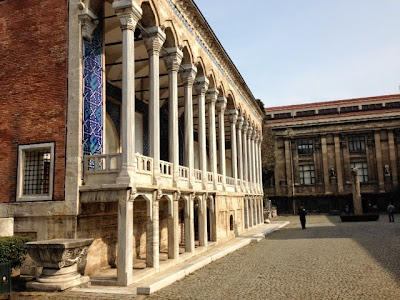The Archaeology Museum, Üsküdar
My last day in Istanbul was a day for tying up loose ends. I had already visited all the "greatest hits" on my list, so to speak, and looking at what else to do there were four options: the Museum of Islamic Arts, the Kariye Museum, the Archaeology Museum and a visit to Üsküdar.
The Museum of Islamic Arts is closed for renovations and the Kariye Museum looked really far away at two or three tram transfers, so that narrowed down the list of eligible museums down to one: the Archaeology Museum, which is right next to Topkapi Palace, accessible either from the First Court itself, or from Gülhane park. It spans three buildings, the main one being a big Neoclassical construction that houses most of the collection. There's also a small pavilion with blue tiles:
I don't know if there was something in the water today, but when I got to the ticket booth the poor man and woman inside were having to deal with an old French lady who kept listing names of palaces and museums at the clerk, seemingly arbitrarily, asking where each one was (I noticed while waiting a big sign at the museum's entrance saying "THIS IS NOT TOPKAPI PALACE"). She kep asking about Yildiz Palace, which I hadn't even heard of, and the clerk just couldn't convince her that A) this was not it, and B) it wasn't even close. The lady eventually gave up, sighed and walked into the museum.
After the French lady, before me, there was an entire Arab family who simply wanted to know if they could enter for free, "it's just to show the kids you see". The woman behind the counter was like "Um, no?", but then they passed them over to a different employee and they switched to Arabic, so I missed the end of that story!
When it was finally my turn, I just said, "One entrance, please. To this museum." The two employees just looked at me with a silent "That's it?".
Given the richness of Istanbul's history, you can imagine how varied and abundant the museum's collection is. They have a huge amount of funerary stelae, engravings and markings from the prehistoric times until the Byzantine Empire, as well as an expansive collection of Babylonian remnants: wall decorations, column bases, vases and amphorae... However, as with the Louvre, the section that most caught my eye was the one dedicated to Graeco-Roman sculpture, with a good number of pieces that dated back to the Roman Empire before the Byzantine Empire split off.
The crown jewel of the entire museum is the Alexander Sarcophagus, so called because it's decorated with scenes of Alexander the Great's battles, not because it belonged to him. The sarcophagus is immense and incredibly well preserved for a work dating back to the 4th century BC. The perfectly detailed bas-relief still showed traces of pigment where they had been painted. 2,300 years later! Amazing!
I spent most of my time admiring these marble sarcophagi and statues, and then gave a more cursory walk through the prehistoric section, which didn't interest me as much.
After soaking in the ancient history of the region for the better part of the morning, I treated myself to a nice rooftop restaurant with a superb view of the entire Sultanahmet and even Beyoglu on the other side. I sat inside, though, because by this point I could spontaneously combust if I get any more sun. I think it's been sunnier these five days in Istanbul than it was all of August in Versailles last year. I had baklava and tea for dessert while I tried to make out all the landmarks I've visited.
For the afternoon, I walked to the pier at Eminönü and took a ferry to Asia! More specifically, to Üsküdar, one of Istanbul's neighbourhoods on the Anatolian (Asian) side of the city. The ferries take just a few minutes to cross the Bosphorus and conviently operate on the same token system as the trams and the underground.
Üsküdar is apparently one of the more conservative quarters of the city, and it became apparent as soon as I stepped off the ferry: fewer tourists, a lot more veils, everything looked more residential, fewer businesses and restaurants on sight... Truth be told, there isn't really much to do or see there -the guides simply list all the mosques in the neighbourhood, but then aren't all the grand mosques in the old city?
In any case, I took a relaxed walk along the breezy, bright shoreline, drinking in the skyline of Sultanahmet and gazing at the sea. If you grew up on the seaside, you know that you miss just seeing the sea when you're out.
I walked in front of Leander's Tower, which isn't a tower but a lighthouse (and I see in Wikipedia that it wasn't even correctly attributed to Leander, so way to go, whoever named it), a mediaeval lighthouse still shining between Europe and Asia. It looks really small from land.
After that nice seaside walk, I was just about spent, so I decided to call it a day and head back to Europe. When I got back to the square between Aya Sofya and the Blue Mosque, it was sunny, all the tulips were blooming, and there were people everywhere. This wraps up my Byzantine holiday, as I'm leaving tomorrow morning. Towards the end I kinda ran out of things to do, so in hindsigt I would've booked one day less, and I'm really dying to be able to walk down the street without being bothered every thirty seconds, but otherwise it's lived up to my expectations and I leave filled with history and awe.
Where will we go next?









Constantinople? Sorry, I had to do it.
ReplyDelete